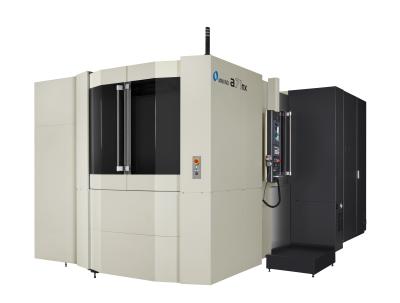
Makino announces the latest addition to its next-generation series of horizontal machining centers, the a71nx. This horizontal machine platform extends the capabilities of the original a71 with a host of brand-new features and technologies, including an expanded work envelope, improved ergonomics, increased spindle torque, innovative tool monitoring, advanced motion controls and the new Professional 6 control.
“The a71nx expands on all of the characteristics that made the original a71 an industry leader,” said David Ward, horizontal product line manager at Makino. “By expanding machine capacity and integrating cutting-edge technologies, like Vision B.T.S. [broken-tool sensing] and advanced motion controls, Makino has successfully leveraged proven design attributes while enhancing the productive capabilities and overall reliability.”
Designed for the production of midsized cast iron and light alloy parts, the a71nx features a 19.7-inch (500-mm) pallet and added extensions in the X, Y and Z axes, bringing full-axis travels to 31.5 inches, 29.5 inches and 32.7 inches (800 mm, 750 mm and 830 mm), respectively. The expanded axis travels increase the total machining volume 16 percent compared to the original a71. To accommodate these larger workpieces, the maximum payload was also raised, providing capacity for parts weighing up to 1,000 kg.
Larger parts frequently require larger tools. As such, the a71nx has been updated to handle longer and heavier tools. The machine’s standard 60-tool-capacity automatic tool changer (ATC) has six reinforced pockets, yielding a maximum tool length of 18.9 / 22.4 inches (Cat / HSK) and maximum weight of 30 kg.
Additionally, the original a71’s standard worm-gear-driven NC rotary table has been replaced with a direct-drive (DD) motor B-axis table for dramatically faster indexing time. The 1-second 90-degree rotation improves production processes with a substantial reduction in non-cutting motion. The DD motor table on the a71nx also reduces B-axis complexity and eliminates backlash and key component wear for improved reliability.
The a71nx takes spindle reliability and productivity to a new level with an updated high-power spindle design. With options available for CAT-50, BT 50 and HSK-A100 interfaces, the standard 10,000-rpm spindle offers 37kW of power (26kW continuous power) and 512 Nm of torque (305 Nm continuous), delivering the flexibility and speed necessary to efficiently machine a variety of ferrous, hard metal or light alloy workpieces. The large-diameter angular contact bearings and direct-inject air-oil lubrication ensure the highest level of rigidity and longevity. An optional 20,000-rpm core-cooled spindle is also available.
Similar to other Makino nx-Series horizontal machining centers, the a71nx benefits from an innovative casting design and axis construction. The tiered, or stepped, column casting and oversized roller linear guides boost rigidity, eliminate vibration and extend perishable tool life even in the most challenging materials.
Chip and coolant management has been improved with the addition of a standard hydro-cyclonic filtration system. This system cleans coolant down to a 20 μm level, extending the maintenance life of the coolant.
One of the key advantages of the a71nx is its ability to reduce non-cut time from part processes with innovative, patent-pending hardware and control features.
A vision-type broken-tool sensor (Vision B.T.S.) comes standard, supporting unattended operation by quickly validating the condition of cutting tools after each tool change. By creating a silhouette of the cutting tools, Vision B.T.S. is also able to evaluate the size and approximate weight of the tool. This information can then be applied to automatically set the tool-change speed to the appropriate setting (fast, medium or slow). The Vision B.T.S. system has fewer moving parts and requires no physical contact with the cutting tool, resulting in enhanced, long-term reliability and no risk of chipping delicate tool materials, such as polycrystalline diamond (PCD).
The a71nx is also equipped with the latest inertia active control (IAC) technologies, providing enhanced acceleration and deceleration rates in the B-axis, Z-axis and rotational positioning of the ring-type tool magazine. By quickly evaluating the total weight placed on these axes, IAC technology is able to instantly adjust acceleration to match the total load, reducing non-value-added times from part processes.
With the addition of the new Professional 6 (Pro6) control, the a71nx is equipped with two of the latest forms of advanced motion control to minimize non-cut time:
- GI Drilling is a unique G-code drilling cycle that enables the spindle and tool to arc from hole to hole instead of following a square path. This simple change reduces non-cut time by as much as 15 percent on common hole-pattern drilling.
- GI Milling is designed to improve performance in 2-D milling. GI Milling lets the user define a corner-rounding tolerance on each milling path. Even a small tolerance enables the machine to quickly flow through the cut path, completing milling paths in less time.
Together, these functions substantially cut costs in both high-volume and low-volume production environments by reducing the number of spindles required and freeing up machine availability to take on more work.
The exterior of the a71nx has evolved in an effort to make maintaining the machine easier for the operator. An L-shaped door, when open, allows more light to enter the machine and prevents fluid from dripping onto the operator during inspection and maintenance. The wide opening on the pallet-loading station doors lends easy access for loading of fixtures and large workpieces. This type of accessibility is crucial for part loading and unloading in robot-automated environments.
Contact Details
Related Glossary Terms
- 2-D
2-D
Way of displaying real-world objects on a flat surface, showing only height and width. This system uses only the X and Y axes.
- backlash
backlash
Reaction in dynamic motion systems where potential energy that was created while the object was in motion is released when the object stops. Release of this potential energy or inertia causes the device to quickly snap backward relative to the last direction of motion. Backlash can cause a system’s final resting position to be different from what was intended and from where the control system intended to stop the device.
- centers
centers
Cone-shaped pins that support a workpiece by one or two ends during machining. The centers fit into holes drilled in the workpiece ends. Centers that turn with the workpiece are called “live” centers; those that do not are called “dead” centers.
- coolant
coolant
Fluid that reduces temperature buildup at the tool/workpiece interface during machining. Normally takes the form of a liquid such as soluble or chemical mixtures (semisynthetic, synthetic) but can be pressurized air or other gas. Because of water’s ability to absorb great quantities of heat, it is widely used as a coolant and vehicle for various cutting compounds, with the water-to-compound ratio varying with the machining task. See cutting fluid; semisynthetic cutting fluid; soluble-oil cutting fluid; synthetic cutting fluid.
- gang cutting ( milling)
gang cutting ( milling)
Machining with several cutters mounted on a single arbor, generally for simultaneous cutting.
- milling
milling
Machining operation in which metal or other material is removed by applying power to a rotating cutter. In vertical milling, the cutting tool is mounted vertically on the spindle. In horizontal milling, the cutting tool is mounted horizontally, either directly on the spindle or on an arbor. Horizontal milling is further broken down into conventional milling, where the cutter rotates opposite the direction of feed, or “up” into the workpiece; and climb milling, where the cutter rotates in the direction of feed, or “down” into the workpiece. Milling operations include plane or surface milling, endmilling, facemilling, angle milling, form milling and profiling.
- numerical control ( NC)
numerical control ( NC)
Any controlled equipment that allows an operator to program its movement by entering a series of coded numbers and symbols. See CNC, computer numerical control; DNC, direct numerical control.
- payload ( workload)
payload ( workload)
Maximum load that the robot can handle safely.
- polycrystalline diamond ( PCD)
polycrystalline diamond ( PCD)
Cutting tool material consisting of natural or synthetic diamond crystals bonded together under high pressure at elevated temperatures. PCD is available as a tip brazed to a carbide insert carrier. Used for machining nonferrous alloys and nonmetallic materials at high cutting speeds.
- tolerance
tolerance
Minimum and maximum amount a workpiece dimension is allowed to vary from a set standard and still be acceptable.
- work envelope
work envelope
Cube, sphere, cylinder or other physical space within which the cutting tool is capable of reaching.

